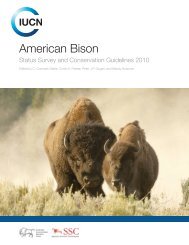Declaration Dr. Thomas H. Pringle - Buffalo Field Campaign
Declaration Dr. Thomas H. Pringle - Buffalo Field Campaign
Declaration Dr. Thomas H. Pringle - Buffalo Field Campaign
You also want an ePaper? Increase the reach of your titles
YUMPU automatically turns print PDFs into web optimized ePapers that Google loves.
ears (Ursus americanus), and brown bears (Ursus arctos) as well (Appendices 2-1 and<br />
2-2) (Wasser et al. 1997; Kohn et al. 1999; Lucchini et al. 2002; Murphy et al. 2002).<br />
Noninvasive fecal DNA studies in primates reported the lowest AS and highest AD rates<br />
relative to our study results (Appendices 2-1 and 2-2) (Bradley et al.2000; Lathuillière et<br />
al. 2001; Morin et al. 2001).<br />
We found no large effect of extractions to error rates. Therefore, only one<br />
extraction per fecal sample is necessary prior to screening for quality. It would be much<br />
more cost effective and efficient to perform one extraction, and screening for sample<br />
quality with a single multiplex PCR, before using a sample for complete genetic studies.<br />
For mtDNA, we successfully amplified high quality sequences from 93% of fecal<br />
DNA extracts on the first attempt. Sequences that produced nucleotide mis-<br />
incorporations that did not match any previously described haplotypes were PCR<br />
amplified and sequenced at least once more. This resolved all nucleotide mis-<br />
incorporation errors. Seven apparently low quality samples yielded ambiguous sequences<br />
with multiple overlapping nucleotide peaks. Repeated PCR amplification and sequencing<br />
did not resolve this issue. However, our success rate for amplifying scoreable haplotypes<br />
was much higher than for scoreable microsatellite genotypes. The higher success is most<br />
likely due to the fact that mtDNA occurs in multiple copies within each cell. Therefore,<br />
mtDNA studies from fecal samples may require collection of only about 10% more<br />
samples in the field than necessary, as opposed to 25% more for microsatellite studies.<br />
The per nucleotide error rate (0.0005) for fecal DNA generated by our study<br />
demonstrates that caution must exercised in identifying new haplotypes through<br />
sequencing. Our fecal DNA extracts produced higher than average nucleotide mis-<br />
24










